[wpaudio url=”http://www.pjhstudios.com/blog/wp-content/uploads/2012/07/minisky.m4a” text=”Patrick J – Miniature Sky” dl=”0″]
Category: Personal Projects
All personal projects that I’ve worked on or made.
-
31 flavors of ice cream in 30 days
For the month of June, I gave myself the silly challenge of doing a Baskin Robbins: eating 31 flavors of ice cream. To count, I had to eat at least three spoonfuls of the flavor. I couldn’t cheat by standing at a counter in an ice cream shop and ask for a taste test. Plus, the person behind the counter would get annoyed. They get annoyed if you ask for two taste tests.
I learned quite a bit in my pursuit of testing my tastes in ice cream. Ben and Jerry’s, on the whole, sits heavily in stomach. Häagen-Dazs slides smoothly across the taste buds. Perhaps it’s the bias of my Texas childhood, but Blue Bell brings about a comforting feeling with a spoonful. Flavors of ice cream have gone corporate sponsored, combining other popular products or even famous brand names. Oreos, Butterfingers, Stephen Colbert, Starbucks. Jumping food mediums seems to be the norm, causing an exponential assortment of choices in a frozen food aisle. Also, conveniently, where the pint used to be the guilty pleasure size for all midnight snack runs, serving containers can be carried away by the armful at three ounces. A pint of ice cream in a Texas summer inside a car can increase unsafe driving speeds.
Godspeed, I ate ice cream for all three meals one day. I threw a mini ice cream party for snack day at work. The sales clerks at various Walgreens knew me as I rolled in, heading towards the frozen food section. I could have continued this dessert trip for a long time, perhaps six months or more with all the unique flavors of ice cream, and that’s not including the overlap of basic chocolate, vanilla, strawberry, etc. flavors or the assorted vanilla flavors that Blue Bell alone sells. And, potentially, with the advent of Coldstone or Marble Slab, where you can add mix-ins, you can up your flavor count considerably with the permutations and combinations of Heath crunch and a dozen flavors.
Stats:
- 7 Ben and Jerry’s
- 8 Blue Bell
- 1 Braums
- 2 Coldstone
- 1 Dryers
- 5 Haagen Dazs
- 1 Marble Slab
- 1 Starbucks
- 1 purchased at Trader Joes
- 4 from restaurants
The full list is below, and I made note if there was anything interesting related to it, be it by flavor or experiential.
- Ben and Jerry’s Cherry Garcia: overrated, flavors too subtle.
- Ben and Jerry’s Chocolate Fudge Brownie
- Ben and Jerry’s Peanut Butter Cup: like a lead weight in my stomach.
- Ben and Jerry’s Stephen Colbert Americone Crunch
- Ben and Jerry’s Cookie Dough: the flavor to kick off the month.
- Ben and Jerry’s Envision World Peace
- Ben and Jerry’s Chunky Monkey: Surprisingly good.
- Blue Bell Cookies and Cream.
- Blue Bell Red Velvet: Surprisingly good; enjoyed outside while 4 Fort Worth PD officers arrested someone across the street from Sweet Sammie’s.
- Blue Bell Dutch Chocolate: Mini ice cream party flavor number one.
- Blue Bell Cotton Candy: frozen torture that didn’t even taste like cotton candy.
- Blue Bell Crazy Cookie Dough
- Blue Bell Homemade Vanilla: Mini ice cream party flavor number two.
- Blue Bell Mint Chocolate Chip: a classic.
- Blue Bell Moo-lineum Crunch: interesting mix of flavor.
- Blue Sushi Green Tea: heavy on the green tea; I’ve had better.
- Blue Sushi Raspberry Vanilla
- Braums Peppermint Ice Cream: for a birthday.
- Coldstone Pine-berry: like a gelato; ate in the company of a 31 year old and a 3 year old.
- Coldstone Cheesecake: definitely needed a mix in, which I did not do.
- Dryers Butterfinger
- Haagen Dazs Dulce de Leche: delightful; Walgreen’s sales clerk was impressed I knew how to pronounce it.
- Haagen Dazs Chocolate Chocolate Chip
- Haagen Dazs Butter Pecan
- Haagen Dazs Rum Raisin: I’m not a rum fan, so why I picked this horrible choice is beyond me. Pirate, maybe?
- Haagen Dazs Blueberry Crunch: Amazing.
- Lanny’s Brown Butter: eaten in the company of an engagement celebration and a graduation celebration; also, the last flavor for the month.
- Marble Slab Coffee
- Shinjuku Station Red Bean: I love Shinjuku Station. Enjoyed with a swizzle stick and Yamazaki whisky.
- Starbucks Java Chip Chiller
- Strawberry mochi: a Japanese style of ice cream I picked up from my first trek to Trader Joe’s.
-
Google and Duck Duck Go search results comparison
I couldn’t remember what Apple’s pricing was for their print on demand publishing for books. Â So, I googled.
That’s… not helpful. Â Let’s try Duck Duck Go.
Helpful, easy to see what I need, and answers my question. (Note: screenshots are same size.)
Just for fun, I blocked out all the non-search result content for the Google version.
Pitiful.
-
How to have a whiskey tasting

Whiskey bottles in my collection on display for a whiskey tasting. How to host a whiskey tasting
1. Know the difference between the types of whiskey.
2. Decide which whiskies you wish to share.
3. Be able to talk about a) whiskey in general, b) each individual whiskey.
4. Serve food.Recently, I held a whiskey tasting for a small group of friends. Over the past several months, I’ve amassed a small collection of whiskies, and decided to share them. I announced a date far enough in advance to make sure enough could plan and attend. Prior, I asked around, casually, if people would be interested. There were, with several admitting their lack of whiskey knowledge.
In between the booking of the date and the tasting, I did research. In order to get a history of the drink, I ordered a copy of Kate Hopkins’ [easyazon-link asin=”B00375LMUM”]99 Drams of Whiskey: The Accidental Hedonist’s Quest for the Perfect Shot and the History of the Drink[/easyazon-link]. 99 Drams tells of Kate and her friend in search of what would make someone spend $10,000 on a rare bottle of whiskey. As they search, Kate tells of how whiskey and the various types—scotch, scotch whisky, Irish whisky, bourbon and other variants came to be. Like all alcohol, sordid political games influenced the making and evolution of the drink. The book provided enough insight and clarity to cover the distinction between the different kinds. It’s like a travelogue for whiskey.
I also picked up two coffee table books, which were basically the same. [easyazon-link asin=”0756654432″]World Whiskey[/easyazon-link] and [easyazon-link asin=”0789497107″]Whiskey: The Definitive World Guide[/easyazon-link]. Both contain many of the same pictures and same basic facts. World Whiskey is newer, and I feel, better organized. Lastly, I purchased a whiskey tasting guide, [easyazon-link asin=”0955472954″]Jim Murray’s Whisky Bible[/easyazon-link], an odd, legal envelope shaped book with a plethora of tasting notes for thousands of whiskies. It’s hard to read but interesting guide.
All books were purchased used on Amazon for a total of less than $20. Wikipedia helped with some minor details and pictures. I browsed whiskey maker websites to learn their story. One thing Kate Hopkins talks about in 99 Drams is, how much a maker’s story is true, or marketing embellishment. A good story doesn’t affect taste.
For the tasting, I chose a sampling of the 3 main types—an Irish, a scotch (whisky) and 2 bourbons, for a total of 4 tastings. They could then have a drink of any of the 4 they tasted or venture into my whiskey collection. Before deciding on the four tastings plus one drink menu, I debated how many to serve. With everything at least 80 proof, I was going to have to minimize the serving size, number of servings and be up front with everyone showing up having eaten a hearty meal.
To serve the tasting to a large group, I ordered two ounce plastic cups. They’re large enough to be held easily, distributed quickly and to pour small amounts evenly in. Given that you’re supposed to wait one hour per alcoholic drink consumed, I wasn’t going to serve full shots of whiskey. Each two ounce cup would contain about a half an ounce. The half ounce would suffice to see the color of the whiskey, smell it, and taste it and its finish.
To finish out the tasting, I researched food pairings. Dark chocolates go with most scotches, pecans go with most bourbons, gouda, brie and water crackers go with most Irishes. I filled out the party plate with deli meat and pretzels. Several whiskey sites suggested fried chicken and bourbon (or American whiskey). Perhaps next time, I’ll get some Babe’s Fried Chicken to go and share an assortment of bourbons.
Lastly, I made a slide deck in Keynote, transferred it to the iPad and used my iPhone to control the presentation. I made the deck to keep everyone on the same footing, and with a noisy room of drinks being passed, the slides would set a bearing to what was being said. Plus, the pictures or words would trigger what I needed or wanted to say. Afterwards, I made notes in my head about how to rearrange the slides if I were to do this again.
People arrived, and I offered water to everyone. We began.
All the tasting articles suggested to start with the lightest whiskey first. This is akin to wine tasting. Similarly to wine tasting, you use four senses to fully taste the whiskey—sight, smell, touch (with your tongue, is the whiskey thick, thin, oily) and taste (for flavors and the finish which can leave different flavor notes). Dissimilarly to wine tasting, you add water to whiskey for a tasting. Debates rage about this practice and about how to drink whiskey in general. The water opens up various compounds from the alcohol and lessens the bite of the alcohol. High proof whiskies should be watered down to get their full flavor. For a drink, a splash of water will do. For a tasting, a few drops will work.
We started with the Powers Gold Label Irish whisky.
(Trivia: typically, Scotch and Irish whiskey varieties spell whiskey without the e, and the US does. There are exceptions but it’s a general point.)
Then we moved to a bourbon, Basil Hayden’s.
Third, Maker’s Mark.
Lastly, Johnnie Walker Black.
In between tastings I would go through a few slides about the history or the process of making the drink. Whiskey is just as diverse as wine or beer, but with most spirits containing at least 40% alcohol, the barrier to entry is higher. Personally, I’d like to see smaller bottles to lower the risk of trying a new whiskey, however, for most distillers, such a practice isn’t viable. I’ve surmised that to find what you like, take risks, ask the folks at the liquor stores, research whiskey. A devoted contingent of whiskey bloggers and tasting sites and magazines do exist. Have friends pick a bottle for a party. Different bars serve different spirits, especially four or five star hotel bars in different parts of the country. Like all subcultures, there are passionate people of all types. What’s exciting, is that Fort Worth will soon have a distillery, Firestone and Robertson.
And, did you know, that if you distill beer, you get whiskey?
-
Ten years on, he still stands
Ten years on, new stories find a way to be told about that day. Everyone owns a part of history, however far removed they were from the events that occurred. September 11, 2001 horrifically created a common experience.
My experience became real, running late to a business law class and arrived to a visibly upset professor. Upon hearing the news from his students he said, in a broken voice, “I can’t do this today, class dismissed.â€
Everyone left in search of news, finding nothing to make sense of the morning.
The morning after, September 12, I woke up early to seek out a New York Times. By 8 am there were no copies left in the student union, the grocery store across from campus, nor the convenience store a block away. You Tube, Facebook and social media as we know it today, let alone the scale of internet news didn’t exist. A physical newspaper still retained meaning, as if to say, “yes, yesterday did happen.â€
Twice a week, I submitted political cartoons to the campus newspaper, the TCU Daily Skiff. The cartoon for September 12 was already published. I called an editor and told them I’d have a cartoon for them by mid afternoon.
I sat at my desk, in my dorm, with my sketchpad and wrote down a few words. What did I want the cartoon to say? A good political cartoon evokes an idea with minimal need for words. The Skiff’s cartoon for the 12th was that of a dark grey bust of the Statue of Liberty, torch held high, and a white, contrasting tear falling down her cheek.
Powerful, somber, resonant.
Somber.
I couldn’t do that the next day. I had to go a different direction. Horror? Anger? Defiance? Resilience? Depressing? Ashes? Smoke? Flags? Firefighters? Police? Uncle Sam…
Uncle Sam, ashes, smoke…
There’s a Pearl Jam song, Given to Fly, where the line at the climax of the song, Eddie Vedder sings, “At first he was stripped, then he was stabbed by faceless men, well fuckers, he still stands.â€
“He still stands.â€
Uncle Sam still stands amidst all the ashes and rubble and smoke.
The song continues on, “He still gives his love, he just gives it away.â€
I’ve got the image in my head and quickly sketch it out. I then draw on the paper I use to submit the cartoon and pencil the basic image and finish with the inks. I turned the cartoon in that day, and it ran September 13th.
I chose resilience.
= = =
I’ve since lost the original inked version. Moving tends to misplace pieces of paper. Below is the only remnant of that cartoon.

-
Photo proof you don’t get it right the first time
Below shows that the best shot isn’t the first one you take. Iteratively and progressively, you build on what worked, and use your knowledge to make it better. Also, stuff happens in post-processing of images. As an aside, I prefer to shoot in aperture priority mode to control my depth of field, and I’ll comment on settings for folks, if they’re into that sort of thing.
This is with a bare flash (Vivitar 285HV wide zoom, 1/16th power and camera at f 8, aperture priority). The flash is too bright, nuking the army dude with light. Need to soften the light a bit.
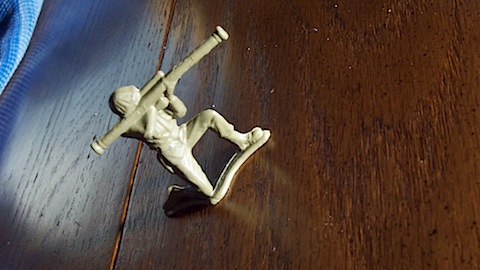
A few shots later, I put a Wescott mini-Apollo softbox over the flash. The softbox is about 10″x6″ and fits on the head of the flash well. The light is softer and direct, but the image needs something more than an army guy on a table.
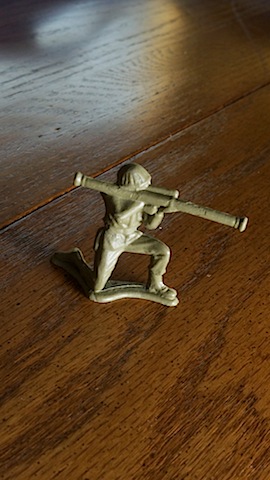
They defend stuff, right? So I grabbed the salt and pepper shakers, letting the title of “defending the shakers” float in my mind. Ok, it’s somewhat interesting, but white light seems a bit much.
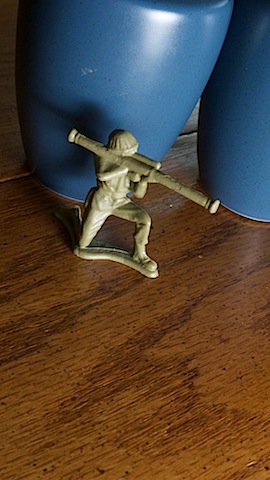
I took the softbox off the flash and added a warming gel and reattached the softbox. I really like this…
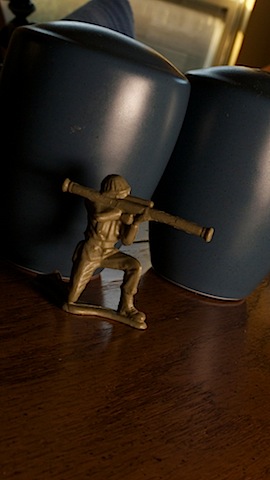
…and let’s punch it up a bit in post-processing, changing the levels, tweaking the curves and upping the saturation.
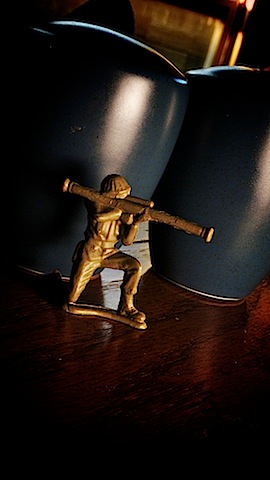
Continuing on, I added a machine gunner buddy. Cool, but what if I added some light behind them?
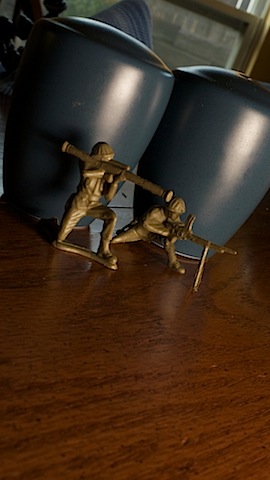
I placed a LumoPro 160 (1/8th power, zoomed to 85mm, placed a foot from the army guys). I should have known it would have been too hard (it’s like a flash grenade went off).
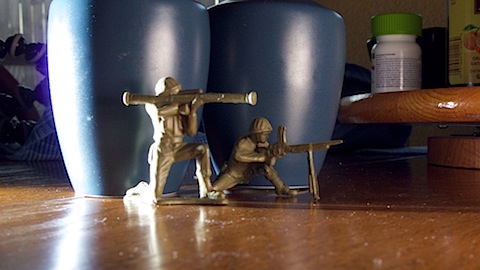
I moved the LumoPro to a counter top, so now that flash is about 6 feet away with the Vivitar still sitting pretty. Like earlier, the white light isn’t doing it for me.
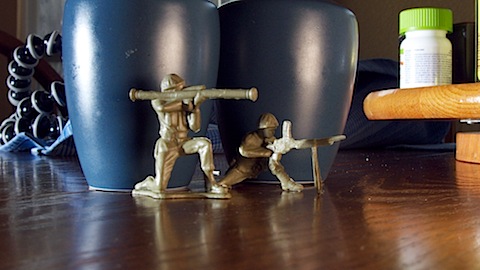
I placed a warming gel on the LumoPro, took a few shots, and this is the one I like. Sharp and warm and with a good angle.
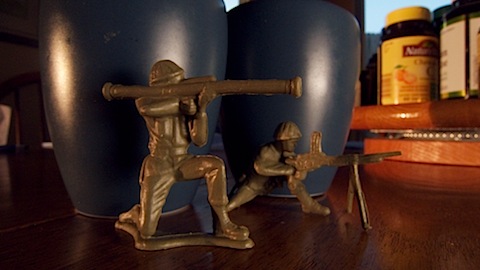
…and now punched up in post-processing like above.
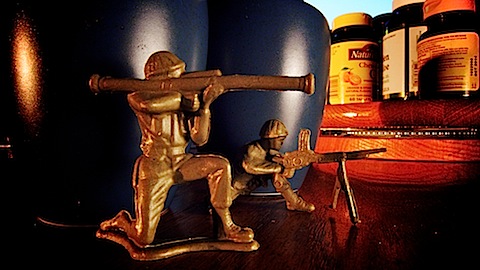
-
Seryn unplugged in my living room
To get a band to play in your living room, there are several steps to make it happen.
- Find an intimate setting large enough to fit a band and their equipment.
- Get owner of said place to agree to let a band play in their intimate setting.
- Ask said band to play in said intimate setting.
Inspired by two stories posted to Fuel/Friends music blog, by Heather Browne, I pitched the idea to my parents: to put on a show in the living room for my birthday. Reticent to the idea, I strategically, I loaded up the potential band’s music on the kitchen computer and played it for them as I talked about how cool it would be for a 30th birthday experience. Once the soothing, serene harmonies of Seryn filled the kitchen, they began to seem amiable.
“Sure, email the manager, to see if they’ll play.”
A week’s worth of emailing with the band’s manager passed and we worked out a deal. It would cap off a 4 day run of shows for the band. Seryn would play, unplugged, in my living room. I relayed the news to my parents, and they were shocked and impressed, and possibly wondering what they committed themselves to.
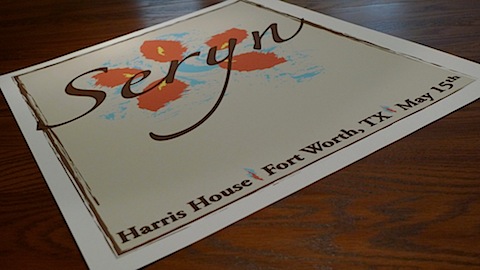
Invites were sent, food ordered, the band’s whisky purchased, last minute details cleared up, logistics finalized, poster made, living room cleared, margarita machines stocked, and the dog tranquilized with doggie downers.
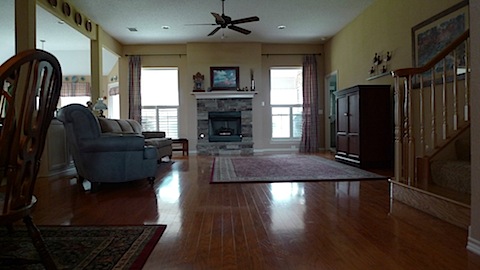
People began arriving around 4:30, and the band followed, unloading around 5. They arrived in their bus, a midnight blue shuttle bus, pulling a trailer for their gear. One by one, they entered the house placing an assortment of instruments from a stand up bass, pump organ, tambourines, banjos and xylophone. And in a small world moment, Nathan, the red-bearded guitarist, and my brother, exchanged glances and immediately recognized each other.
“Hey, I know you… from UNT.”
“Yeah, you were in Bruce…”
“… and you had a girlfriend back home…”
“… you did too…”
“… and we’d talk about it all the time… “
“How you been?!”
Everything was fine.
The stage was set, and fajitas were shared, and margaritas and whisky were dispersed for the set. At five after six, a sizable crowd swelled within the confines of the kitchen to the dining room to the stairs. I thanked everyone for coming, and introduced the band.
Trenton spoke, “Hi, we’re Seryn, and we’re happy to be here to play a few songs for you and celebrate Patrick’s birthday.” And they transitioned into Of Ded Meroz.
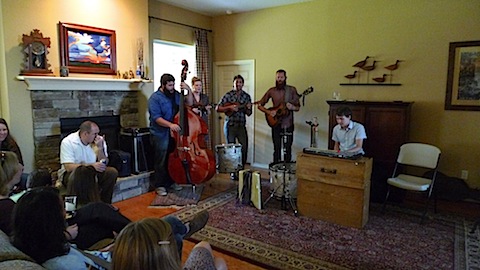
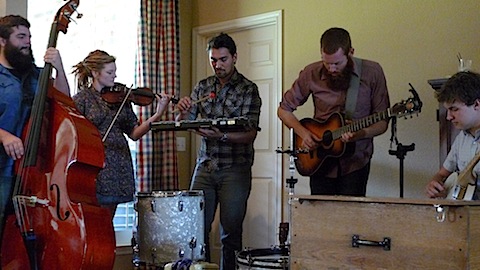
For an hour Seryn played, switching instruments mid song, applying bows to a banjo and a xylophone during On My Knees, singing in 5 part harmony, jamming out, letting the music ebb and swirl and coalesce into a rousing finale of Here We Are. This is a band you have to see live, for their energy, passion and camaraderie, and you can’t help but feel that and get a sense of something bigger, something hopeful, and joyful.
Friends and family lined up at the makeshift merchandise stand at the dining room table, picking up cds for themselves or others and T-shirts, too.
It was a memorable night. Chelsea, Trenton and Nathan told the story of how they all joined up (fyi, an Explosions in the Sky show is involved); my father helping Andrew, the merch guy, fix the band’s box o’ wares; taking a shot of whisky with Trenton and Nathan, Aaron showing me their spiffy Square credit card processor; my friend Mark collecting autographs with a silver Sharpie; my friend Brad suggesting the addition of a cowbell; the margarita machine drained dry; Chris arriving just in time from a wedding.
All in all, I’m incredibly grateful, humbled and appreciative for all the people who came out to celebrate my 30th.
-
What I learned from 46 days of no Facebook
In keeping with the Catholic tradition of sacrificing something for Lent, I chose to give up Facebook. In the past, I’ve given up chocolate, sweets, dessert, beer, alcohol, caffeine, soda, (listening to) music. Forsaking a technological medium that seeks to connect people, and purposefully disconnecting from it, goes against the instant gratification of modern life. I still had email, cell phone, Twitter, a mail box people could send mail to (I received a postcard during that time). At one point, I consulted with a Lentor, to determine if I could view Facebook at all or just my own account. Consensus deemed that viewing Facebook through others to be OK.
As an aside, the term Lentor was coined at a birthday dinner when a friend had a question about not swearing. A different friend quickly intervened, heading off any moral quandary and designating himself as a Lentor, one who can determine the applicable boundaries of a Lenten sacrifice. I’m sure a priest could have served the role, but what lay person wouldn’t want to help set some tangible, real world spiritual chalk lines?
Facebook is pervasive
If Lenten sacrifices have blurry lines, then Facebook obliterates whatever constraints social communication had. For so long, communication remained tethered to the real world. Written letters, phone communication, voice mails, face to face, text messaging seems fairly grounded in comparison. In casual conversation, referencing Facebook is such a common occurrence that Facebook itself is the communication medium. Yes, its content resides on a digital cloud somewhere in California, but consider:
“… posted pictures on Facebook…”
“… on Facebook, [so-and-so] said [funny/stupid/innocuous/inane/sad/maddening comment] on my wall…”
“… received a Facebook invite for…”
“… just send me a message on Facebook…”
“… are you on Facebook?”
“… you can get our hours of operation on Facebook…”
“… did you see [so-and-so’s] status on Facebook?”
[Insert entire recounting of Facebook realm drama here that ultimately makes its way in to every day life.]
While waiting for someone at Blue Mesa, I overheard two different conversations related to things occurring or having occurred on Facebook. It wasn’t the internet, a blog but a website that, as we all learned from watching the Social Network, put the social experience online. A website that stands to make money off electronic social interactions better than any blog ever did.
At a birthday party, I joked with an acquaintance that we weren’t officially friends since we weren’t Facebook friends. Since this occurred during Lent, I told her I couldn’t friend her right away.
“Can it wait until Easter Morning?” I said.
“Sure, I’ll be expecting a friend request at 12:01, Easter Morning.”
“What about after sunrise service?”
The Fear Of Missing Out
Facebook makes us more connected in a passive way, making it easy to see photos, updates and changes in people’s lives. It also accentuates something that’s always existed–the fear of missing out. That sense of anxiety when there’s something out there that we’d like to experience but are not able to for some reason or another, often due to simply not being informed.
In grade school, you’d figure out which birthday party you missed by hearing about it on Monday while hanging out by the monkey bars. Now, someone you don’t even know will upload a photo from a bar while hanging out at a bar with a stuffed monkey in the back room and tag a friend you know, alerting you of fun you never knew existed. Or were invited to.
The fear of missing out applies to keeping up with status updates and the miscellany of conversation commenting on photos, videos or links. We want to be part of those conversations, even if we’re lurking, passively consuming the updates. What if we miss out on something funny, or engaging or interesting? We want to know. This has been true for any media or form of communication. We’re social creatures, despite however much someone claims to be an introvert. We want to be connected to others and validated by others. I’m guessing there’s some evolutionary biology behind connection and validation. Survival of the species, perhaps?
Biologically, within your brain, you’re wired to become engaged with novelty, things that interest you. When something interests you (intellectually, emotionally or physically) your body will crank out various hormones to further engage you. Dopamine, adrenaline, oxycontin are a few, and to enjoy those activities more, we need a more novel or bigger hit of those activities. This is why relationships are hard work–the novelty of the initial attraction wears off, and then you have to work at maintaining that attraction.
And Facebook is an amusement park of attractions, the equivalent of a 100 different roller coasters of digital crack. It’s novel, interesting, engaging, relatively easy to consume and there’s always a reason to come back for more. A good drug dealer gets you hooked with free. All Facebook costs you is time. So a free means to engage passively with social connections leads to all sorts of things, one being the need to keep up with others so you don’t miss out.
Curated lives
In keeping up with others, there’s the opposite, informing others. Anyone who posts things to Facebook is a publisher, a modern day William Randolph Hearst, albeit at a much smaller scale, for a much more individual purpose.
Hearst is credited with saying to a photographer, “You provide the pictures, I’ll provide the war.” Regardless, if he ever said it, the point is that what ever means is used, we can justify the ends to say something. We might not be selectively curating lolcat pictures or YouTube videos for war, but we selectively signal our interests and intentions by what we share or say.
Travels, growing families, melancholy thoughts, persistent witticisms, innocuous oversharing, politics, sports, gossip, social causes, personal happenings… Imagine whatever you publish to Facebook as a room in your own personal gallery. What’s that gallery going to look like? Curators discern what hangs on the wall at a museum with subject matter smarts and an intent to editorialize to show or say something.
Wouldn’t your Facebook postings do the same?
You know yourself (you should), and you want to tell people something, and you choose what you want to say.
You’re curating your own life. And we each have our own reasons for doing that.
Offline
But what about those that don’t reside on Facebook, or never post anything beyond setting up their page with a picture and basic information? I don’t think they’re missing out, despite the pervasiveness and growing necessity to communicate via Facebook. They have their ways of keeping in touch, getting whatever social interaction floats their boat and living life how they want to. Meaningful lives can still be lived without Liking or Statusing or Poking or Inviting or Messaging. Meaningful lives can still be lived with conversations, however infrequent they may occur. Meaningful lives are not defined by the content or quantity of Facebook updates.
-
Designing a challenge coin
Belly up to the bar with a number of active service members, you could easily issue a challenge, and most should be able to place a brass, bronze or silver-like coin on the table. The person who can’t show their coin buys the round of drinks. Wikipedia tells a storied origin of a downed WWI pilot, whose sole identification was his coin, which prevented him from being executed by the French. These coins carry a special source of pride among those who carry them and are collectibles, especially if you know what one is. Bud, a friend of my father’s, who served with him in Vietnam, had his Green Beret challenge coin stolen from him by a small town cop after a night in jail. My father, many years later, found someone to make a replica and gave it to Bud as a birthday present.
Later this summer, my father is going to Portland for a reunion for his unit, the Sea Cobras, an inshore undersea warfare group, stationed in Qui Nhon. He commissioned me to do the design.
Since most coins use the unit’s insignia, I started with the patch. (Of note, original, military issue patches are worth money.)
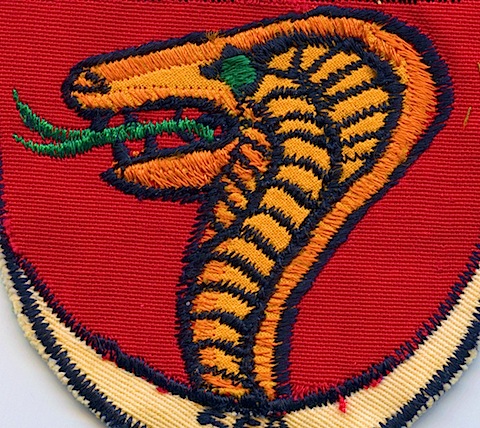
I wanted to keep the simplicity of the sea cobra, so in Illustrator, I cleaned up the lines and evened out the color. Since the coin maker was going to do the embossing, I chose a serif font and the general placement of the text, and my original design instructions were to make the entire coin red.

Working with the coin maker, my father made the final decisions, and the final coin shown below. He chose to have the embossed text stand out more, removing the outer red ring. There’s a slight raise to the outline of the cobra to give it depth, and the yellow is muted as compared to the mock up, above. The coin measures 1.5 inches in diameter and weighs a solid 4 ounces. All in all, he made a print run of 100, and I get one.






